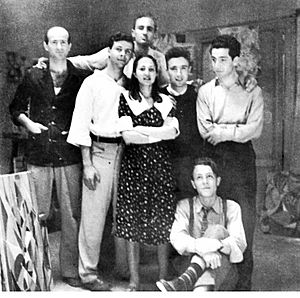Piero Dorazio facts for kids
Piero Dorazio (born in Rome on June 29, 1927 – died in Perugia on May 17, 2005) was an Italian painter. His art was a type of abstract art, which means it used shapes, colors, and lines instead of showing real-life objects. His work was similar to styles called color field painting and lyrical abstraction.

Early Life and Art Groups
Piero Dorazio was born in Rome. His father worked for the government, and his mother loved history and art. Piero went to high school in Rome. In 1943, his family moved to Abruzzo to escape the war. After the war, he worked as a translator for the British Army. Then, he studied architecture at the University of Rome.
Piero was interested in the art movement called Futurism. Artists like Gino Severini and Giacomo Balla inspired him to paint. However, he didn't agree with their political ideas. So, he joined artists like Renato Guttuso, who had different views.
In 1947, Dorazio, along with Pietro Consagra, Achille Perilli, and Giulio Turcato, started an abstract art group called Forma I. They wrote a statement about their art. Even though they had ideas about society, they focused on bringing back abstract art. They didn't want to just paint realistic scenes about social issues. In the same year, Dorazio won a prize and money from the French government to study art in Paris.
In 1950, Dorazio helped open L'Age d'Or. This was a special bookstore and art gallery just for abstract art. In 1952, he helped start another group called Origin with Alberto Burri and others. He also edited an art magazine called Arti Visive.
Travels and Teaching
In 1953, Dorazio traveled to the United States for the first time. He represented Italy at a seminar at Harvard University. That fall, he moved to New York City and stayed there until 1954. In October 1953, he had his first art show all by himself at George Wittenborn's One-Wall Gallery.
In 1955, he wrote a book called La Fantasia Dell-Arte Nella Vita Moderna. It was about modern art in Italy. In this book, Dorazio believed that abstract art could change the world. He thought that just like science and technology were connecting different cultures, a new "universal style" of art would lead to a "universal civilization."
In 1959, he was invited to teach painting at the University of Pennsylvania School of Design. He taught there for one semester each year from 1960 to 1969. He split his time between the United States and Italy. In 1970, he moved back to Rome to live and work full-time. In 1974, he moved his art studio to Umbria, near Todi.
Piero Dorazio was known for being a person who spoke his mind. His art style stayed the same over time. He is most famous for his paintings that use thick lines of bright colors and crisscross patterns. Even though his paintings are abstract, they have many details and are complex. His style is often called "Post-painterly abstraction."
Exhibitions
Some of the art shows that have featured Dorazio's work include:
- 1952 Venice Biennale
- 1953 Wittenborn One-Wall Gallery, New York
- 1960 Venice Biennale
- 1965 "The Responsive Eye", Museum of Modern Art, New York
- 1970 André Emmerich Gallery, New York
- 1979 Retrospective, Musée d'Art Moderne de la Ville, Paris
- 1980 Albright-Knox Art Gallery, Buffalo
- 1985 "Bilder für Frankfurt", Museum für Moderne Kunst Frankfurt
- 1987 "Dalla Pop Art alla nuova figurazione", Collezione del Museum für Moderne Kunst al Padiglione d‘arte contemporanea Milano
- 1990 Le Magasin, Grenoble
- 1991 Galleria d'Arte Moderna, Bologna
Recognition
- Prix Kandinsky (1961)
See also
 In Spanish: Piero Dorazio para niños
In Spanish: Piero Dorazio para niños

